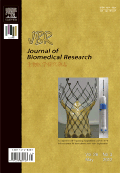
Genes & Diseases
Scope & Guideline
Shedding light on the genetic foundations of disease.
Introduction
Aims and Scopes
- Molecular Genetics and Disease Mechanisms:
Research exploring the genetic basis of diseases, including the identification of mutations, polymorphisms, and their roles in disease progression. - Transcriptional and Epigenetic Regulation:
Studies on how transcriptional control and epigenetic modifications influence gene expression in the context of various diseases. - Cancer Biology and Therapeutics:
Investigations into the molecular mechanisms of cancer, including tumor microenvironment interactions, signaling pathways, and therapeutic targets. - Immunology and Autoimmunity:
Research on immune responses in disease states, including the role of immune checkpoints, inflammatory pathways, and autoimmune conditions. - Stem Cell Biology and Regenerative Medicine:
Exploration of stem cell mechanisms, differentiation, and their therapeutic applications in disease treatment and tissue regeneration. - Metabolism and Disease:
Studies on metabolic pathways and their alterations in diseases such as obesity, diabetes, and cancer, focusing on therapeutic implications. - Neurobiology and Neurodegenerative Diseases:
Research into the genetic and molecular underpinnings of neurodegenerative diseases, including Alzheimer's and Parkinson's disease. - Infectious Diseases and Host Response:
Investigations into the genetic factors affecting susceptibility to infectious diseases and the host's immune response mechanisms.
Trending and Emerging
- Multi-Omics Approaches:
There is a growing emphasis on integrating genomic, transcriptomic, proteomic, and metabolomic data to provide a comprehensive understanding of disease mechanisms and therapeutic targets. - Precision Medicine and Personalized Therapies:
Research focused on tailoring treatment strategies based on genetic and molecular profiling of patients is gaining traction, reflecting the shift towards individualized healthcare. - Ferroptosis and Regulated Cell Death:
Ferroptosis, a form of regulated cell death, is emerging as a significant area of research, particularly in its implications for cancer therapy and neurodegenerative diseases. - Immunotherapy and Cancer Microenvironment:
Studies exploring the interactions between cancer cells and the immune microenvironment, including the role of immune checkpoints and tumor-infiltrating lymphocytes, are increasingly prominent. - Gene Editing Technologies:
The application and implications of CRISPR and other gene editing technologies in treating genetic disorders and cancers are trending, highlighting their potential for future therapies. - Role of Non-Coding RNAs in Disease:
Research into the functions and mechanisms of long non-coding RNAs (lncRNAs) and circular RNAs in various diseases is on the rise, emphasizing their potential as biomarkers and therapeutic targets. - Microbiome and Human Health:
Explorations of the relationship between the microbiome and various diseases, including metabolic and autoimmune conditions, are becoming a significant focus. - Neuroinflammation and Neurodegeneration:
Research on the mechanisms of neuroinflammation and its role in neurodegenerative diseases is gaining importance, reflecting a broader understanding of brain health.
Declining or Waning
- Traditional Genetic Association Studies:
While genetic association studies remain important, there has been a noticeable shift toward more integrative approaches that combine genomics with other omics data, leading to a decline in standalone genetic association studies. - Basic Mechanistic Studies Without Clinical Relevance:
Research that focuses solely on basic mechanisms without a clear clinical application or relevance is becoming less frequent, as the journal prioritizes studies with translational potential. - Single-Factor Analyses in Complex Diseases:
There is a decrease in studies that analyze single genetic or molecular factors in complex diseases, with a growing preference for multi-factorial and systems biology approaches. - Historical Reviews on Established Diseases:
Reviews focusing on well-established diseases without new insights or perspectives are waning, as the journal seeks fresh, innovative content that addresses current research gaps.
Similar Journals

FEBS Journal
Advancing the Frontiers of Biochemical ResearchFEBS Journal is a prestigious, peer-reviewed publication dedicated to advancing the field of biochemistry, cell biology, and molecular biology. Published by WILEY in the United Kingdom, this journal boasts an impressive impact factor and ranks in the top quartile (Q1) across multiple relevant categories, including Biochemistry, Cell Biology, and Molecular Biology, reflecting its significant contribution to scientific research. With an ISSN of 1742-464X and an E-ISSN of 1742-4658, the FEBS Journal publishes original research and comprehensive reviews that push the boundaries of knowledge and innovation in the biosciences. As a vital resource for researchers, professionals, and students alike, the journal offers Open Access options, ensuring that cutting-edge discoveries are accessible to a broad audience. With a publication history converging from 2005 to the present and a robust emphasis on high-quality scholarly work, the FEBS Journal remains an essential platform for the dissemination of significant findings and advancements in the life sciences.

Cell Discovery
Pioneering Discoveries in Molecular and Genetic SciencesCell Discovery, published by SPRINGERNATURE, is a premier open access journal in the dynamic fields of Biochemistry, Cell Biology, Genetics, and Molecular Biology. Since its inception in 2015, this journal has established itself as a key platform for disseminating high-impact research and is recognized with a Q1 ranking across all its core categories for the year 2023. With its remarkable Scopus rankings—7th in Genetics, 9th in Biochemistry, 13th in Molecular Biology, and 15th in Cell Biology—Cell Discovery positions itself among the elite journals in life sciences, showcasing the most innovative breakthroughs and comprehensive reviews. Based in the United Kingdom, this journal operates under an open access model, ensuring that groundbreaking discoveries are readily available to researchers, professionals, and students around the globe. With a commitment to advancing scientific knowledge, Cell Discovery welcomes contributions that push the frontiers of our understanding in cellular and genetic sciences.

MOLECULAR AND CELLULAR BIOCHEMISTRY
Elevating Knowledge in Biochemistry Since 1973MOLECULAR AND CELLULAR BIOCHEMISTRY, an esteemed journal published by SPRINGER, serves as a prominent platform in the fields of biochemistry and molecular biology. With a history of dissemination since 1973, this journal has made significant contributions to the understanding of biochemical processes at the molecular level. The MOLECULAR AND CELLULAR BIOCHEMISTRY journal focuses on a myriad of topics including but not limited to cellular biochemistry, clinical biochemistry, and interdisciplinary approaches in medicine, boasting a commendable categorization in the 2023 Scopus ranks where it falls under Q3 in Cell Biology, Q2 in Clinical Biochemistry, Q1 in Medicine (miscellaneous), and Q2 in Molecular Biology. Although the journal is not open access, it provides access options through institutional subscriptions, making valuable research accessible to a wider audience. With its rigorous peer-review process and high impact within the scientific community, this journal aims to advance knowledge and stimulate exploration in biochemical research, making it essential reading for researchers, professionals, and students alike.

Journal of Biomedical Research
Pioneering Insights in Biochemistry, Genetics, and Molecular BiologyJournal of Biomedical Research, published by Nanjing Medical University in China, is a prominent platform for groundbreaking discoveries in the fields of Biochemistry, Genetics, and Molecular Biology, as well as Medicine. With an ISSN of 1674-8301 and an E-ISSN of 1876-4819, the journal offers a vital opportunity for researchers, professionals, and students to disseminate insightful research findings. Although not currently available as an open access journal, its inclusion in the second quartile of both Biochemistry and Medicine categories underscores its growing influence and commitment to high-quality scholarship, as evidenced by its historical compliance with Scopus rankings prior to 2009. By fostering an interdisciplinary approach, the Journal of Biomedical Research aims to bridge gaps in current biomedical understanding and encourages innovative research that can lead to significant contributions in improving health outcomes. Its editorial policies guarantee rigorous peer review, making it a trusted source of knowledge in the biomedical community.

CELL RESEARCH
Connecting Research to Real-World ImpactCELL RESEARCH is a premier peer-reviewed journal dedicated to advancing the field of cell biology and molecular biology, published by SpringerNature. With an impressive impact factor and consistently ranking in the Q1 quartile for both cell biology and molecular biology, this journal serves as a pivotal resource for researchers, professionals, and students seeking to explore the latest discoveries and advancements in cellular mechanisms and their implications for health and disease. Since its inception in 1996, CELL RESEARCH has cultivated a distinguished reputation, currently boasting ranks in the top percentile of Scopus categories, reaffirming its influence and relevance to the scientific community. Although it is not an Open Access journal, its rigorous selection process ensures the publication of high-quality articles that contribute significantly to our understanding of life sciences. For those deeply engaged in the realms of biochemistry, genetics, and molecular biology, CELL RESEARCH is an essential conduit of innovative research and critical insights.

FASEB BioAdvances
Connecting Researchers Through Open Access ScienceFASEB BioAdvances, published by WILEY, is an esteemed open-access journal dedicated to advancing the fields of biochemistry, molecular biology, and physiology. Since its inception in 2019, the journal has rapidly established a significant presence within the academic community, boasting an impressive impact factor reflective of its Q2 and Q3 standings across various categories, including Biochemistry, Genetics and Molecular Biology, Cancer Research, Molecular Medicine, and Physiology. The journal aims to disseminate high-quality research and innovative findings to enhance the understanding of biological processes, making it a vital resource for researchers, professionals, and students alike. With its commitment to open access, FASEB BioAdvances ensures that groundbreaking research is available to a global audience, facilitating collaboration and exploration in these rapidly evolving scientific domains.

MOLECULAR AND CELLULAR BIOLOGY
Unveiling Cellular Mechanisms for a Brighter TomorrowMOLECULAR AND CELLULAR BIOLOGY, published by TAYLOR & FRANCIS INC, stands as a preeminent platform for researchers, professionals, and students engaged in the dynamic field of molecular and cellular biology. Established in 1981 and ongoing into 2024, the journal features cutting-edge research that spans across vital sub-disciplines, garnering a strong impact in its contributions to the scientific community. With an impressive Q2 ranking in Cell Biology and Q1 ranking in Molecular Biology for 2023, it consistently publishes high-quality articles that reflect the latest advancements and discoveries within the field. The journal is particularly well-regarded for its rigorous peer-review process and commitment to scientific excellence, making it an invaluable resource for those seeking to deepen their understanding of molecular mechanisms and cellular processes. Although not open access, the journal offers diverse access options for researchers to reach the latest findings. By maintaining a strong focus on biochemistry, genetics, and molecular biology, MOLECULAR AND CELLULAR BIOLOGY remains essential reading for anyone looking to contribute to or stay informed about significant developments within this pivotal area of study.

CELL
Unraveling the complexities of life at the molecular level.CELL is a premier academic journal in the field of Biochemistry, Genetics, and Molecular Biology, published by CELL PRESS. Founded in 1974, this esteemed journal has steadfastly contributed to advancing our understanding of cellular processes and organisms, making it integral for researchers and practitioners alike. With an impressive impact factor that places it in the Q1 category of its field, CELL ranks #1 out of 221 in general biochemistry and genetics, achieving a remarkable 99th percentile in Scopus rankings. Though it is not currently an open-access publication, the journal regularly disseminates high-quality research that impacts the scientific community significantly. Researchers, students, and professionals seeking to stay at the forefront of innovative discoveries and methodologies in molecular biology will find CELL an invaluable resource through its comprehensive articles and reviews.

Life Science Alliance
Unlocking Potential in Life Science Research.Life Science Alliance, published by LIFE SCIENCE ALLIANCE LLC, is a premier open access journal that has been making significant contributions to the fields of Biochemistry, Genetics and Molecular Biology, Ecology, Health, Toxicology and Mutagenesis, and Plant Science since its inception in 2018. With an impressive ranking in Scopus, including Q1 quartile positions and high percentiles in relevant categories, this journal is a vital resource for researchers, professionals, and students alike who seek to advance knowledge and innovation in life sciences. The journal operates on an open access model, ensuring that research findings are freely available to the global scientific community, thereby enhancing the visibility and impact of published work. With a commitment to fostering collaboration and disseminating high-quality research, Life Science Alliance serves as an essential platform for the promotion and exchange of scientific knowledge, aiming to bridge gaps and stimulate discussions across multiple disciplines.

Cell and Bioscience
Advancing the Frontiers of Bioscience ResearchCell and Bioscience is a prestigious open-access journal published by BMC that has been at the forefront of biochemistry, genetics, and molecular biology since its inception in 2011. With an impressive impact factor, this journal has established itself as a vital resource for researchers and professionals in these rapidly advancing fields, reflecting its high ranking of #29 out of 221 in the Scopus classification and placing it in the 87th percentile. Based in the United Kingdom, Cell and Bioscience aims to foster innovation and dissemination of research findings addressing critical biological questions through rigorous peer-reviewed articles and inter-disciplinary approaches. The journal's open-access model ensures unrestricted access to transformative research, promoting collaboration and knowledge sharing among academics, students, and practitioners worldwide. With a commitment to maintaining excellence in the field, Cell and Bioscience provides an essential platform for those looking to contribute to the evolving landscape of biosciences.